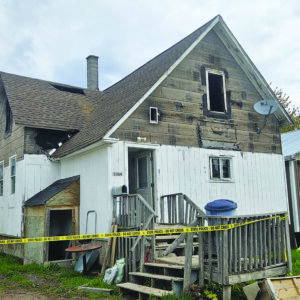A notable designation
L'Anse recognized by MEDC

Ben Garbacz/Daily Mining Gazett (from left) Kristina Waara, Chris Miller, Ryan Perrigo, Robert LaFave, Ronald Ervast, Jen Tucker, Jason VanStraten, Leann Davis and William Menge pose for a picture of the RRC Essentials designation presentation. Tucker said L'Anse is the fourth community in the U.P. to receive the designation.
L’ANSE — The Village of L’Anse has received Redevelopment Ready Community (RRC) Essentials designation from the Michigan Economic Development Corporation (MEDC). The village council announced the recognition at its regular meeting Tuesday. At the meeting, the council also approved an agreement with the Michigan Department of Natural Resources for a Waterways Marina Grant.
The meeting began with reports from the village department heads, which mostly consisted of repairs and work being done in connection to this months flood damage. Lead man for Water Distribution Lyle Olsen said he has been involved with fixing washouts and culvert pipes. Olsen said the Secret Creek culvert pipe was washed out and there is work being done to assess and fill sinkholes. Olsen said Meadowbrook Field next to Pat’s Foods required a lot of cleanup consisting mainly of sediment.
Some council members reported between four and eight inches of rain at their homes prior to the flooding. Village Manager Robert LaFave said he was proud of all the workers and their response to the emergency. “Everybody did what they were supposed to do,” he said. “All the work that we collectively have done over the last 18 years, this could have been way worse if it weren’t for all the work that we put into modernizing our wastewater system and all the work we’ve done on culverts and things of that nature over the last several years.”
MEDC Redevelopment Services Director Jen Tucker presented the council with the RRC Essentials Designation. It is one of two designations in the RRC Program, with the essentials designation signifying a community has the essential practices needed to fulfill a vision the community has set in place for the future. Tucker said the village began the process of redevelopment readiness in April 2017 and it was this self evaluation which helped earn the designation.
“So things like how you as village council members are educating yourselves, or what does local zoning say about a project that actually meets your vision that’s identified in the master plan, for example? So a lot of these efforts were tailored specifically to the village in order to meet the best practices, and really melding them to make sense on a local scale here in L’Anse,” Tucker said.
Tucker highlighted three goals in the report that which were of interest. The first goal was continued participation in local area economic development activities, such as engagement with the MEDC. The next was marketing vacant village owned and privately owned land for developers, which Tucker said was working on prioritizing sites on a local level that fits the village’s vision and making plans to connect the sites with the appropriate personnel in the development community. Third was enhancing quality of life opportunities within the village, which includes eliminating blight and improving recreation opportunities and fostering development of new housing and supporting downtown revitalization.
Tucker said L’Anse is the fourth community to achieve the status in the U.P. and 30th in Michigan overall.
“So you’re part of a small, very elite group that has their act together. So welcome. These are all very critical resources to ‘Making it in Michigan,’ which is kind of our slogan nowadays. So thank you for helping keep that going and keeping that alive. We want to keep working with you guys and keep it flowing,” Tucker said.
The council approved the MDNR Waterways Marina Grant agreement. The grant will amount to half a million dollars and go into studying the engineering work for future plans for the marina in L’Anse. “This will help us lay down the foundation that we’re going to need to get the next phases of work done,” LaFave said. “It’s going to involve moving that rock dock around and create some more space for more boats make it more user friendly. But also, one of the big components of this is setting it up so we’re not having to do $50, $60 or $70,000 worth of dredging every couple of years with the way that things work around the lake, with the river down there.” He said a material transport study is expected to take place to observe how sediment is trapped and where it goes during storms. This will help determine a new break wall location in the future.






